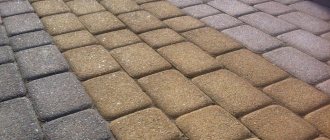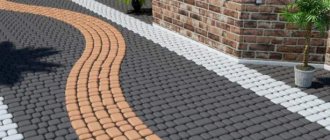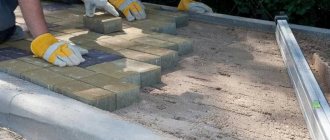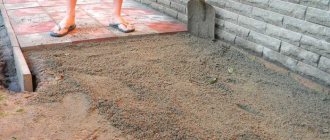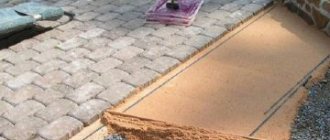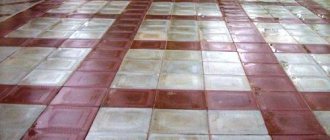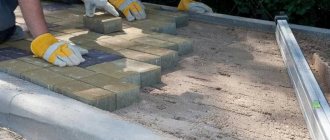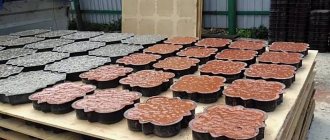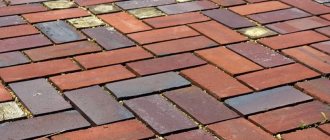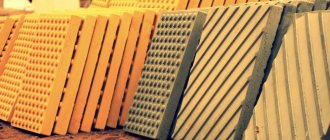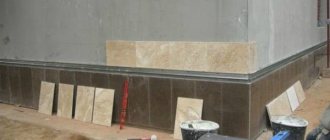Preparing the mixture for laying paving slabs is an important stage in landscape design, which must be approached responsibly. Compliance with technological rules and requirements will allow you to create a high-quality composition and make the design reliable. Otherwise, the tiles will be laid incorrectly, and cracks will form during its operation.
Composition and preparation of sand-cement mixture for laying paving slabs
Preparing the mixture for laying paving slabs is an important stage in landscape design, which must be approached responsibly. Compliance with technological rules and requirements will allow you to create a high-quality composition and make the design reliable. Otherwise, the tiles will be laid incorrectly, and cracks will form during its operation.
How to clean grout from tiles
After laying the tile surface, drops of mortar often fall on the surface, which spoils the appearance of the path. It is necessary to approach the installation process with special care and remove drops immediately after contact with the tiles. The solution itself must be kept at a distance from the path so as not to spill it.
Solidified splashes can be carefully scraped off using a spatula or sanding machine. Chemicals should not be used for this purpose, since the acids in their composition disrupt the properties of the cement mortar and damage the tile elements.
Cleaning cement from tiles Source ytimg.com
Types of styling
Any work on the design of a personal territory begins with drawing up a plan, choosing materials and paving methods. To implement such tasks, it is necessary to take into account a number of points.
First of all, you should determine:
- The type of soil that will serve as the foundation.
- Anticipated surface loads.
- Relief of the area allocated for paving slabs.
- Coverage area.
- Material consumption.
- Method of paving tile products.
Experts use the following methods of laying tiles:
- On a pillow of sand.
- For cement-sand mixture.
- For cement-sand mortar.
- On a concrete screed.
Laying on sand
At the same time, laying paving stones on sand is in great demand due to the following advantages:
- The presence of a sand cushion promotes good drainage - during heavy rainfall, all the water ends up in the seams between the paving stones, which eliminates the possibility of puddles.
- Due to the absence of a monolithic connection between the surface of the track and its internal structure, with minimal seismic activity or ground movements, the structure is not subject to deformation.
- Caring for sand-mixed tiles is quite simple. If one element is damaged, you can quickly dismantle it and replace it with a new one.
However, in addition to the advantages, this installation method also has disadvantages:
- If you do not provide a good drainage system and free flow of water, accumulated moisture will lead to deformation of the structure.
- Exceeding the permissible loads will also lead to cracking of the tiles. So, if you drive a car over a tiled surface, the result will be disastrous.
Owners of private houses and summer cottages often complain that ants carry away sand from under the tiles.
For a dry mixture of sand and cement
The use of a cement base mixed with sand for paving tiles is in great demand.
This technology has the following advantages:
- Ensuring high strength properties.
- Increased resistance to heavy loads.
The disadvantage of this option is its high cost. There may also be a problem with the pillow being washed out by heavy rains. To eliminate such problems, special curbs should be provided around the perimeter. The process of securing these elements complicates installation.
Otherwise, laying paving slabs on sand is relatively easy. Even if there are no skills in this field of activity, the owner of the site will be able to perform paving. But in order to prevent possible errors and problems, it is important to strictly follow the technology and not deviate from the step-by-step guide.
On a concrete screed
The most durable and resistant to heavy loads base is concrete. It protects the tile covering from cracks and deformations when exposed to precipitation, soil movements or external mechanical loads. This makes a concrete pad the only solution for those paths on which people or vehicles will constantly walk.
Paving stones can also be placed on a dry cement mixture in a ratio of 1:3. To obtain the best performance characteristics, it is recommended to use a mixture of grade 400. All components are thoroughly mixed, but no water is added. The sand should remain clean and dry, so it can be sifted through a sieve to remove impurities. Only clean sand can guarantee the strength and high quality of the screed.
Advantages and disadvantages
The attractiveness of a tile covering depends not only on the type of product, but also on the correct arrangement of elements on the surface. An important stage of the work is preparing the base for the paving stones. When choosing a laying method, it is recommended to take into account the landscape features and soil properties. Sandy material is used for groundwater drainage. Moisture that comes with precipitation or during hydraulic cleaning of the surface penetrates through the seams of the laying elements. The canvas is made up of separate fragments that move relative to each other, so the coating retains its shape. The tiles, located on a sand base, ensure ease of maintenance of the canvas. If a piece of installation is damaged, it can be easily removed and replaced with a new one. It is recommended to purchase materials for landscaping in reserve so that they can be replaced at any time. Such structures have their drawbacks, which can be caused by violations of the preparatory work technology. In the absence of a well-equipped drainage system, the sandy base is destroyed. Arrangement of a water drainage system is an important stage in the design and execution of work
The laying surface is designed for maximum permissible loads, so when arranging it, it is important to take into account the purpose of the coating. The quality of installation depends on the professional skills of the master. Therefore, it is recommended to contact companies that provide coating installation services.
If you carry out the work yourself, you need to carefully read the recommendations, choose high-quality material and arrange the foundation, taking into account the water level and climatic conditions of the area.
Preparing the bed for the sidewalk
The process of preparing a bed for future paving with paving slabs consists of several stages. First of all, you need to choose the material and place where the coating will be installed.
Selection of location and material
When choosing a location for installing a tile covering, it is necessary to give preference to flat areas where there are no depressions and close groundwater.
There are two types of paving slabs available for sale, which differ in their production method:
- Manufactured using vibration casting.
- Manufactured using vibrocompression.
When choosing the appropriate option, it is necessary to take into account the operating environment and expected loads. Vibropressed tiles are suitable for paths on which vehicles will travel. If you need to arrange a landscape design in the garden, it is better to choose a vibro-cast type.
Such paving stones are not able to withstand heavy loads, but have a wide variety of textures, shades and decorative solutions. So, the owner of the site can purchase tiles with an imitation of the texture of wood or stone.
But while additives help improve the strength properties of a structure, water worsens them. To assess the quality of the tiles, try hitting one against the other: when a ringing sound appears, you can be sure that the product is of high quality. A dull sound indicates excess water content.
When purchasing materials from different manufacturers and batches, check to see if they differ in shade. You also need to make sure that the sizes match, since sometimes it can be problematic to find similar products from different brands.
To prevent the problem of shortage of tiles, buy them with a margin of 7-10%, because... One batch may contain defective elements.
Preparing the base for installation
Starting the preparatory work, you should dig a 28 cm deepening (the layer consists of 15 cm of crushed stone, 10 cm of sand and 3 cm of dry mixture). If a lawn is being built near the path, then the calculation is performed using a different formula: 28 cm + height of the tile covering + thickness of fertile soil.
If the soil is soft, it must be moistened with water and then compacted. Then at the bottom of the recess a 15 cm layer of crushed stone is placed. The surface is leveled and compacted.
To prevent mixing of crushed stone with sand, the layer can be covered with geotextiles. A 10-centimeter layer of sand is poured on top of this material. After 2-3 days in sunny weather or the next day in cloudy weather conditions, the surface should be leveled.
The sand-cement mixture for laying paving slabs, the composition of which is selected in a ratio of 8:1, is poured over the sand and leveled. The screed should be level and have a height of 3-4 cm.
Mixture proportions
When choosing cement grade 300-400, the proportions of sand will be 5:1. The use of products under the 500-600 brand requires a different calculation: 1 part cement for 6 parts sand. Often the solution is diluted with PVA glue, which improves the bonding strength. The cement composition with sand and glue is mixed extremely carefully, and then used for its intended purpose.
Step-by-step production of the mixture consists of the following steps:
- 1 part of the cement mixture is combined with 3 parts of sand.
- Next, water is added to the composition - this will give it a creamy consistency.
- After 15 minutes, the components are mixed again.
The surface of the tile that comes into contact with the mortar should be moistened with water.
If the consistency is dry, the paving stones should be laid only after complete leveling. The rows should fit snugly together.
Preparatory excavation work
Further actions depend on what type of base is chosen:
- sand coating;
- sand-cement;
- concrete.
In the first case, the sand is compacted without the use of auxiliary materials. Sand-cement mixture is a more durable coating. After connecting the main components, the trench is backfilled.
Cement mortar is not prepared in this case, but a dry mixture is used. Filling with water is carried out after laying the base. To create a concrete coating, cement mortar is mixed. In this case, formwork is created; the sequence of actions in preparation for excavation work will be different.
The general stage for the formation of any foundation is the excavation of soil in the area where it is planned to lay the tiles. The work is done with your own hands, because in this case there is no need to dig a deep pit, like for a foundation.
The main criteria that should be taken into account when excavating soil are:
- the platform formed from tiles must be flush with the surface of the ground, and so many materials are used so that after shrinkage this requirement is met;
- if the top layer of soil is loose, it is permissible to arrange the covering so that it is 2-4 cm below the ground surface.
In both cases, it is important to take into account the shrinkage of the bulk materials and soil used. When garden paths and sidewalks are laid out, in most cases the thickness of the soil layer that is removed is 20 cm
To make the covering of the area allocated for parking more durable, another 8-10 cm is removed. As a result, the depth of a small pit reaches 30 cm. Material consumption will increase, because in this case it is necessary to create a reliable foundation that can support cars and trucks cars.
Construction of a sand and gravel cushion.
At the stage of removing the soil layer, debris, stones, and weeds are removed. If the surface layer of soil is fertile, it is not recommended to scatter it along the site where construction work is being carried out. Weeds will grow here. This soil is best used for arranging beds and flower beds.
After removing debris and stones, a slope is formed in the direction away from the buildings (no more than 3%). The bottom of the trench is compacted. This will make the future coating more durable, since the risk of soil shrinkage under the weight of the materials used is reduced. Installed.
Materials for filling seams
The presence of seams between each element of the tile covering compromises its integrity. Water will leak through the gaps formed, and in the cold season it will begin to freeze, causing damage to the tiles. When performing installation work, it is necessary to think in advance about how the seams will be sealed.
The next nuisance that will negatively affect the tile covering if there are seams is debris. At the same time, it can be both soft and hard. In case of vibrations that occur when moving along the surface of the tile, it will begin to destroy and scratch the material.
To seal the seams on the tile surface, you need to prepare the following tools:
- Rubber spatula. For such work, it is better to choose a narrow model, but its width is determined depending on the specifics of the cracks. So, if they are long and continuous, it is better to take a wide model. The main thing is that the spatula does not damage the coating.
- Sieve. It will be used to sift sand to seal the seams.
- Concrete mixer. If the unit is missing, you can use any container and a construction mixer with an attachment.
- Shovel and container.
- Broom.
- Buckets and hose.
Waterproofing the base
After the drainage has been installed, it is waterproofed. This event is intended to create protection for subsequent levels from ground moisture. It is advisable to use one continuous piece of material, since over time the joints diverge and begin to let water through. If the base for the platform is being prepared, the strips are sewn together on a sewing machine and covered with aluminum tape on both sides.
The best choice for waterproofing is thick cellophane, sold in rolls. The material is durable, flexible and elastic. It is not subject to rotting and decomposition. At the same time, the polymer does not release harmful substances into the environment.
To increase strength, it is advisable to fold it in half. The edges are brought out to ensure a complete seal. Immediately after laying the polyethylene, it should be sprinkled with sand to prevent it from being blown away by the wind and damaged by sharp objects.
Composition and preparation of sand-cement mixture for laying paving slabs
Preparing the mixture for laying paving slabs is an important stage in landscape design, which must be approached responsibly. Compliance with technological rules and requirements will allow you to create a high-quality composition and make the design reliable. Otherwise, the tiles will be laid incorrectly, and cracks will form during its operation.
Types of styling
Any work on the design of a personal territory begins with drawing up a plan, choosing materials and paving methods. To implement such tasks, it is necessary to take into account a number of points.
First of all, you should determine:
- The type of soil that will serve as the foundation. Anticipated surface loads. Relief of the area allocated for paving slabs. Coverage area. Material consumption. Method of paving tile products.
Experts use the following methods of laying tiles:
- On a pillow of sand. For cement-sand mixture. For cement-sand mortar. On a concrete screed.
Laying on sand
Paving a tiled surface on a sand cushion is justified only in cases where you need to arrange a garden path in a country house or in the courtyard of a private house. This is due to the fact that this type of foundation is not designed for heavy loads.
At the same time, laying paving stones on sand is in great demand due to the following advantages:
- The presence of a sand cushion promotes good drainage - during heavy rainfall, all the water ends up in the seams between the paving stones, which eliminates the possibility of puddles. Due to the absence of a monolithic connection between the surface of the track and its internal structure, with minimal seismic activity or ground movements, the structure is not subject to deformation. Caring for sand-mixed tiles is quite simple. If one element is damaged, you can quickly dismantle it and replace it with a new one.
However, in addition to the advantages, this installation method also has disadvantages:
- If you do not provide a good drainage system and free flow of water, accumulated moisture will lead to deformation of the structure. Exceeding the permissible loads will also lead to cracking of the tiles. So, if you drive a car over a tiled surface, the result will be disastrous.
Owners of private houses and summer cottages often complain that ants carry away sand from under the tiles.
For a dry mixture of sand and cement
The use of a cement base mixed with sand for paving tiles is in great demand.
This technology has the following advantages:
- Ensuring high strength properties. Increased resistance to heavy loads.
The disadvantage of this option is its high cost. There may also be a problem with the pillow being washed out by heavy rains. To eliminate such problems, special curbs should be provided around the perimeter. The process of securing these elements complicates installation.
Otherwise, laying paving slabs on sand is relatively easy. Even if there are no skills in this field of activity, the owner of the site will be able to perform paving. But in order to prevent possible errors and problems, it is important to strictly follow the technology and not deviate from the step-by-step guide.
On a concrete screed
The most durable and resistant to heavy loads base is concrete. It protects the tile covering from cracks and deformations when exposed to precipitation, soil movements or external mechanical loads. This makes a concrete pad the only solution for those paths on which people or vehicles will constantly walk.
To prepare the composition, you need to take 1 part cement and 5 parts sand, mix them and lay them out in a layer of 30-50 mm. Then the surface is carefully leveled and compacted.
Paving stones can also be placed on a dry cement mixture in a ratio of 1:3. To obtain the best performance characteristics, it is recommended to use a mixture of grade 400. All components are thoroughly mixed, but no water is added. The sand should remain clean and dry, so it can be sifted through a sieve to remove impurities. Only clean sand can guarantee the strength and high quality of the screed.
Proportions for vibration casting
The proportions of the solution for vibration casting take into account the following ratio of additives:
- M250/B20 - a bucket of cement, 2 buckets of sand and 3.5 buckets of crushed stone.
- M300/B22.5 - a bucket of cement mixture, 1.7 buckets of sand and 3.2 buckets of crushed stone.
- M400/I30 - a bucket of cement mixture, a similar amount of sand and 2.5 buckets of crushed stone.
In addition to factory-made cements, home-made sand concrete can also be used for vibratory casting. The concrete recipe calls for a combination of 1/3 cement and sand. The volumes of liquid and dry mixture are determined by the weight of the final product.
For gray tiles
If a solution is being prepared for laying gray tiles in Moscow, the following factors must be taken into account:
- Region of use. The resistance of figured products to negative temperatures depends on this nuance.
- Soil and climate conditions. If the region has high groundwater levels, frequent precipitation or high humidity, you will need to reduce the W/C and add additives to the paving mortar that improve water resistance.
- Production technology. If the vibration casting method is used, the surface of the paving stones will be even and smooth. To impart roughness, coarse sand is used.
If a special deep vibrator is used when constructing monolithic buildings, then when laying tiles in a country house or near a private house, you can use the bayonet method inside the formwork using a vibrating table.
Such equipment solves two problems:
- Ensures uniform filling of rigid mixture molds with a minimum water-cement ratio.
- Removes air from concrete, reducing porosity and providing a strong, fine-grained structure with low hydrophobic properties.
For color
The surface of the tile is painted in layers when mixed or in a mass. The first option is more accessible, but requires some skills and effort:
- For the tiles, 2 portions of concrete mixture are created - 2/3 of the volume of gray consistency and 1/3 colored with pigment additives.
- Colored concrete is placed inside the blank.
- The vibration equipment is turned on for 20 seconds.
- After this, the form is filled with plain concrete and processed with a vibrating table for another 40 seconds.
- At the last stage, the mixture is wrapped in polyethylene and moved to a drying area.
During the painting process, the color is added to the concrete mixer. The shade of the tile becomes pale, but even with intense abrasion of some elements, the design of the path does not change.
Preparing the bed for the sidewalk
The process of preparing a bed for future paving with paving slabs consists of several stages. First of all, you need to choose the material and place where the coating will be installed.
Selection of location and material
When choosing a location for installing a tile covering, it is necessary to give preference to flat areas where there are no depressions and close groundwater.
There are two types of paving slabs available for sale, which differ in their production method:
- Manufactured using vibration casting. Manufactured using vibrocompression.
When choosing the appropriate option, it is necessary to take into account the operating environment and expected loads. Vibropressed tiles are suitable for paths on which vehicles will travel. If you need to arrange a landscape design in the garden, it is better to choose a vibro-cast type.
Such paving stones are not able to withstand heavy loads, but have a wide variety of textures, shades and decorative solutions. So, the owner of the site can purchase tiles with an imitation of the texture of wood or stone.
When purchasing material, you need to carefully inspect it for defects, as well as surface features. Both varieties can have a shiny finish, which is explained by the presence of special additives or water in the composition.
But while additives help improve the strength properties of a structure, water worsens them. To assess the quality of the tiles, try hitting one against the other: when a ringing sound appears, you can be sure that the product is of high quality. A dull sound indicates excess water content.
When purchasing materials from different manufacturers and batches, check to see if they differ in shade. You also need to make sure that the sizes match, since sometimes it can be problematic to find similar products from different brands.
To prevent the problem of shortage of tiles, buy them with a margin of 7-10%, because... One batch may contain defective elements.
Preparing the base for installation
Starting the preparatory work, you should dig a 28 cm deepening (the layer consists of 15 cm of crushed stone, 10 cm of sand and 3 cm of dry mixture). If a lawn is being built near the path, then the calculation is performed using a different formula: 28 cm + height of the tile covering + thickness of fertile soil.
If the soil is soft, it must be moistened with water and then compacted. Then at the bottom of the recess a 15 cm layer of crushed stone is placed. The surface is leveled and compacted.
To prevent mixing of crushed stone with sand, the layer can be covered with geotextiles. A 10-centimeter layer of sand is poured on top of this material. After 2-3 days in sunny weather or the next day in cloudy weather conditions, the surface should be leveled.
The sand-cement mixture for laying paving slabs, the composition of which is selected in a ratio of 8:1, is poured over the sand and leveled. The screed should be level and have a height of 3-4 cm.
Mixture proportions
When choosing cement grade 300-400, the proportions of sand will be 5:1. The use of products under the 500-600 brand requires a different calculation: 1 part cement for 6 parts sand. Often the solution is diluted with PVA glue, which improves the bonding strength. The cement composition with sand and glue is mixed extremely carefully, and then used for its intended purpose.
Materials for filling seams
The presence of seams between each element of the tile covering compromises its integrity. Water will leak through the gaps formed, and in the cold season it will begin to freeze, causing damage to the tiles. When performing installation work, it is necessary to think in advance about how the seams will be sealed.
The next nuisance that will negatively affect the tile covering if there are seams is debris. At the same time, it can be both soft and hard. In case of vibrations that occur when moving along the surface of the tile, it will begin to destroy and scratch the material.
Often, garbage is chemically active and triggers negative reactions, including rotting. This process attracts insects and microorganisms, which begin to sharpen the paving stones.
To seal the seams on the tile surface, you need to prepare the following tools:
- Rubber spatula. For such work, it is better to choose a narrow model, but its width is determined depending on the specifics of the cracks. So, if they are long and continuous, it is better to take a wide model. The main thing is that the spatula does not damage the coating. Sieve. It will be used to sift sand to seal the seams. Concrete mixer. If the unit is missing, you can use any container and a construction mixer with an attachment. Shovel and container. Broom. Buckets and hose.
The materials used for sealing joints are sand or cement (you can combine materials to create a mixture of DSP or PCS), as well as water. After preparing all the tools and materials, you can proceed to the main work.
Installation of an exploitable roof
Flat roofs of buildings are often used as open sports, helipads, recreation areas, solariums, swimming pools, parking lots, etc. These types of roofs are called exploitable. Based on the type of purpose of the structure or the form of use, the composition of the structure of the building's covering is selected.
Composition of roof coverings
The coating composition for roofs in use is selected depending on:
· type of supporting structure;
· loads and impacts on the coating;
· climate of the construction area and environmental aggressiveness;
· order of arrangement of layers of the coating structure (traditional, inversion);
· requirements of sanitary and fire safety standards;
· operational properties of the materials used.
One of the main differences between roofs in use is the additional load from the equipment used, the weight of people, vehicles and increased loads from coating materials. Therefore, all load-bearing structures of such a roof must be selected by calculation.
Roofing with straight layers
The composition of the traditional combined roofs in use involves laying the main waterproof carpet on a heat-insulating layer. A leveling screed, most often reinforced, is placed between them.
1 - floor slab; 2 - cement-sand screed; 3 - vapor barrier; 4 - insulation; 5 - waterproofing; 6 - reinforced screed; 7 - main waterproofing; 8 — geotextile; 9 - tiles on plastic supports
Sand-cement mixture for laying paving slabs: composition and proportions per 1m2
Modern technologies and high-quality materials used in the production of paving slabs make it possible to obtain a product with unique properties. Having the opportunity to purchase high-quality material, you need to know how to work with it in order to create a truly wonderful sidewalk. This could be garden paths, platforms and squares, the space in front of the porch or the front door to a country house or cottage. The most attractive qualities for the consumer are the guarantee of a sufficiently long service life, which largely depends directly on compliance with the technological standards of the device and the level of installation on a dry mixture.
How to choose cement
The components of the solution and their proportions directly affect the properties of the product, so the question of which cement to use for paving slabs must be treated with special attention.
The standard for creating the product is the use of M500 cement. The decisive factor when choosing a specific type of material is not so much its brand as its color. Two types of cement are popular: gray, used everywhere, and special white, made from gypsum, clinker and minerals.
Standard gray cement will work for regular gray walkways. White - it is worth choosing for the manufacture of paths with a thoughtful design, if it is necessary to use dyes. In addition to the possibility of painting, this variety is resistant to cold, so the material does not lose its properties in winter frosts.
Cement M500 Source stpulscen.ru
See also: Catalog of companies that specialize in the production of paving slabs.
It is worth considering the cost of the material. White cement is much more expensive than its gray counterpart. When working with white cement, it is necessary to carefully maintain the cleanliness of the workspace and tools, since any fatty impurities and contaminants will spoil the appearance and properties of the tiles.
Mandatory determination of the volumes and boundaries of laying paving slabs
When choosing one of the options for creating a particular object by decorating it with paving slabs, it is necessary to determine the main positions and direction of work:
- Dimensions and shape of a fragment of paving stones.
- Color options, range and composition of colors.
- Determine the purpose of the areas that will be laid. The tiles are great for a parking lot, walkway or area with sufficient traffic.
- Designation of the dimensions and orientation of the site.
- Decide on the need for side trims and additions.
- Clarify how the chosen design will be combined with the surrounding general landscape.
Regardless of any nuances, the selected working area needs a good, high-quality layout with strictly maintained levels and slopes for precipitation runoff.
You can find out what plastic tiles for paths in the country house are by following this link.
How to lay paving stones correctly: technology
How to lay tiles on dry mix correctly? Being carried away by the simplicity and accessibility of all the instructional details and features of laying paving slabs, you need to take everything into account.
This article will introduce you to the basic concepts of how to lay paving slabs.
When considering the solution to global issues in technology and the choice of materials, you should never miss a variety of little things. For novice tilers and lovers of independent activities in landscaping summer cottages and adjacent areas, it is necessary to carefully study all the details of this work.
If you lack skills and experience, you can always get specialist advice on the website or contact a specialized company at the location of the facility. Under the best circumstances, you should never skimp on the tiles themselves or the mixtures on which the paving stone elements will be laid . There are three main installation methods used in today's construction technology. These are the following methods:
- Lay on dry mixtures.
- Installation of paving stone fragments on cement mortar or sand concrete.
- Making a sidewalk using sand as a base.
We also recommend that you familiarize yourself with the original flowerpots for outdoor flowers.
All these methods are equally popular; the choice of one or another depends on the characteristics of the site, the designer’s recommendations, the properties of the soil and the financial capabilities of the owner. For laying on a dry mixture, as in other options, it is necessary not to forget about forming a technological cushion of sand and crushed stone. The process of laying tiles is quite simple, but it requires the worker to be thorough, self-disciplined and patient.
In addition, you also need to know how to install a curb for paving slabs.
Step-by-step laying on dry mix
Steps for laying paving slabs on dry mixes:
- Using a tape measure, pegs and construction twine, the path is marked according to the chosen design and color scheme.
- We prepare the base for the tiles by removing the excess layer of soil and deepening it from 30 to 40 centimeters. Correct laying of the base consists of first pouring a layer of crushed stone of at least 15 cm and about 10 cm of sand.
- Between layers of crushed stone and sand, geotextiles should be laid under the paving slabs. This will prevent sand and crushed stone from mixing and will strengthen the base. After this, the dry mixture should be covered with a layer of a little more than three centimeters.
- Direct laying of paving slabs up to 5-7 centimeters thick.
You may also be interested in the properties of polymer-sand paving slabs.
Calculation of the weight of building materials
Before you start collecting materials, you need to make the correct calculations. Sand and crushed stone can last until the next repair, but cement is not suitable for long-term storage. Therefore, it is first recommended to calculate how much building materials will be needed for the work.
Depending on the type of soil, the thickness of the concrete layer is calculated:
| Swampy soil | Clay soil | Loam |
| Concrete - 7-8 cm Gravel - 5 cm | Concrete - 5-7 cm | Concrete - 10 cm |
In addition to concrete masonry, it is also necessary to take into account the sand base, the layer height of which is from 10 to 15 cm.
The weight of building materials is calculated using the formula LxWxH, where L is the length of the track, W and H are the width and height, respectively.
For example, you need a path with a width of 1 m, a length of 5 m and a height of 0.1 m. The height of the sand cushion will be 10 cm.
Then, according to the formula, you can get the following:
- with a volume of sand (building material is accepted according to GOST) 1x5x0.1 = 0.5 m³ - the weight of the sand from the reference book will be equal to 775 kg;
- with a concrete volume of 0.5 m³, the average weight ratio will be 1075 kg.
Based on the calculation of the proportions “cement-sand-crushed stone” in parts 1:3:1 and the total weight of a cubic meter of concrete, equal to 1075 kg according to the reference book (the total weight is divided into 5 equal parts), the following values can be obtained:
- cement - 215 kg;
- sand - 645 kg;
- crushed stone - 215 kg.
This means that to construct a simple concrete path 1 m wide, 5 m long and a layer height of 10 cm, you will need 215 kg of road cement and crushed stone and 645 kg of construction sand. All calculations are carried out without taking into account the addition of water and various pigment dyes.
Material consumption: proportions, composition
Dry mixtures for laying can be purchased ready-made directly from manufacturers or at any building materials store. They are usually offered in standard packaging of 25, 50, and 100 kilograms. This is a laying mixture consisting of two components - cement and sand allow the work to be done most quickly, and the pavement becomes durable and suitable for use within a few hours after laying. You can make the dry mixture yourself by mixing the ingredients before the process itself in the following proportions. For one part of cement, use four parts of sand, which will allow the path to be guaranteed to be used for at least five years.
The technology for laying paving slabs on sand is described here.
When calculating the required volume of components, take into account that the layer must be at least 3 centimeters. By simply calculating the length, width and thickness of the layer, we obtain the required total volume of bulk components of the mixture. By dividing the volume contained in 1 kg of the mixture, as indicated on the packaging, we obtain the required amount to ensure the consumption for laying the path . If necessary, you can always seek help from companies that perform similar work. Estimating specialists or calculating technicians will accurately and accurately calculate the required amount of dry mixture and separately its components. He will also recommend the brand of cement that will be best suited.
Display
Let's consider what is the technology for laying paving slabs on a dry mixture when you have combined the components in the required quantities:
- The site is prepared before work, leveled and compacted.
- A concrete layer of 15-20 centimeters is created. We will use crushed stone, but it is important to consider that its properties are not so good. If crushed stone is used when laying tiles, it must also be thoroughly compacted.
- For leveling, a two-centimeter layer of sand is poured. A second layer of it is poured on top, one and a half to two times more.
- Reinforcement mesh is installed. Many people do without it, but this element can significantly increase the durability of the structure.
- 15-40 millimeters of the mixture prepared in the previous stages are laid.
- The paving stones are laid evenly. To ensure a tight fit, it is tapped with a rubber mallet or mallet. We must not forget to leave gaps of a few millimeters so that nothing is damaged during expansion.
- The seams are filled with cement mixed with sand.
If it is necessary to install curbs, it is important not to forget to install curb locks on the leveling layer.
In the process of paving with paving slabs, do not forget that the curb must be several millimeters higher than the average surface level, otherwise it will not cope with its tasks.
Which one to choose: review of ready-made mixtures with prices
The best choice is usually a standard commercially prepared dry mix. After all, the main difference between a high-quality concrete mixture is a clear balance of the number of components, ensuring the necessary grade of all components and the environmental safety of the material, since today all building materials produced industrially are subject to the strictest control. Almost all large manufacturing companies have international certificates.
How to lay paving slabs on a concrete base is described here.
The best ready-made dry mixes consist of the following components:
- Crushed granite fraction from 5 mm to 10 mm.
- Sand, fineness modulus not less than coefficient 2.
- Portland cement, preferably grade M-500.
It is possible that you will be interested in material about preparing plasticizer for paving slabs with your own hands.
These are the main components that determine the quality and quality of the dry mix, and therefore the reliability of the tile path. Today, experts prefer universal dry mixes, which are used not only for laying tiles, but also in other construction and finishing works.
The most popular mixtures are:
- Kreisel mixtures for $32. USA per pack of 20 kg.
- Series of mixtures BIRSS, Russia, $1.0 each. USA packaging 25 kg.
- "Vetonit M" 100/600, Finland. Price from 1.0 to 1.75 dollars. USA, package 25 kg.
- PETROLITE price category from 0.85 to 1.55 dollars. USA, 25 kg per bag.
Having a plan for creating a unique path design or decorating a local area, you need to accurately study all the details of the technological methods for laying tiles. Having decided on creating a base from dry mixtures, you need to find out all the positive and negative aspects of this composite material, the features of the composition of industrial mixtures and the price of the quantity you need.
Video
In the video - laying paving slabs on a dry mixture with your own hands:
A newcomer to this field may be surprised by such an abundance of details. In order for you to have a truly reliable and safe high-quality path, the best way would be to use the services of a specialized company performing this work. A professional approach and high quality of work, well-chosen materials and reasonable prices will allow you to enjoy the sidewalk or a completely small path for a long time.
Maybe
How to lubricate molds
You can lubricate tile molds with a specialized industrial lubricant, but for our purpose, spending on a special lubricant may be unnecessary, since its analogues do an excellent job of this task. Allowed to use:
- Machine oil. Use of used consumables is allowed.
- Sunflower oil.
- Ordinary soap solution.
Contrary to popular practice, it is not recommended to use saline solution for this purpose, as it leaves streaks and damages plastic molds. You can use varnish, but this method is only suitable for plastic forms.
Solution for lubricating the mold Source 1stones.ru
Installation technology
Laying paving slabs with your own hands is carried out according to the generally accepted scheme, which implies the presence of several successive stages:
- Project preparation. At this stage of work, the size of future paths or platforms and their placement on the site are determined. They think over the installation scheme of the tile elements and the position of the gutters.
- Excavation of the plant layer of soil. When laying paving slabs, the soil should be removed to a depth of 30-40 cm.
- A sand and gravel cushion is laid. It is designed to uniformly distribute the forces from the loads produced on the created surface. At the very bottom we lay crushed stone in a layer of 15 cm, and after that a 10 cm layer of sand cushion.
- Geotextiles are installed between the materials to prevent their mixing.
- Each layer must be compacted. To do this, use hand rammers or mechanized tools.
- We lay a curb along the contour of the path. Cement mortar is used to fix it.
Existing technologies
Experts identify several main methods of laying paving slabs:
- Laying on a sand cushion. This is the easiest way to lay tiles; you just need to achieve a perfectly level base and fix the material in the sand. The main disadvantage is poor resistance to natural factors. During rainy times, water will flow down the gutters and wash away the sand.
- Laying on cement mortar. In this case, leaching of material is excluded. There are two main disadvantages: the laboriousness of the work process and cracking of concrete due to seasonal movement of the soil, foundation and walls of the building.
- Laying on a sand-cement base. It does not have the above disadvantages and is considered the optimal way to organize a substrate of paving slabs.
- Let's look at the third method in a little more detail.
Installation on sand base
Laying tiles on a dry mixture involves using sand as a mounting layer. Its thickness usually reaches 60 mm. Using clean sand as a base has its advantages and disadvantages. The dry mixture will ideally perform the function of drainage, but is not able to cope with heavy loads. Therefore, such bases are used exclusively on pedestrian paths.
To distribute the dry mixture over the surface, you can use beacons made of galvanized profiles used for installing drywall. They are installed on the prepared surface with a maximum step of 1 m.
Sand is poured into the spaces between the beacons, which are then leveled using a rule. The surface is compacted using a manual tamper or vibrating plate.
After removing the beacons, the resulting holes are filled with sand.
To distribute the mixture for laying paving slabs, you can use a special rule. It is a board, the length of which corresponds to the width of the track. The corners are cut out in it to place the bottom edge on the surface of the base.
In this case, the cuts themselves rest on the previously installed curbs. Sand is poured inside the path, which is leveled by moving the rules.
In this case, the mixture for laying paving slabs must also be compacted. To obtain a better compacted layer, the surface of the sand is watered until puddles appear. The wet mixture is pliable and easy to work with hand tools.
Preparing the base for laying paving slabs
Removing the top layer of soil
From the surfaces planned for laying tiles, remove the top layer of soil 25-30 cm thick, this is approximately one bayonet of a shovel.
If the areas are large, this operation is performed using a bulldozer. The new foundation is then leveled and leveled by hand. If the soil is sandy or sandy loam, then it needs to be compacted. Compaction is carried out using a tamper made by hand from a piece of log 1 meter long with a transverse handle-crossbar nailed to the end. Better compaction is performed by a movable vibrating plate with an electric drive, the use of which, in addition, will save effort and time.
The type of geotextile used in this technology does not matter.
Installation on cement-sand mixture
When using a sand-cement mixture for installing paving stones, you can prepare it yourself or buy it ready-made in bags. In the first case, the recommended composition is 1 part cement and 4 parts sand. This mixture is laid on a prepared and compacted base in a layer of 30-40 cm. To strengthen the coating, it is recommended to first install a mesh of reinforcing bars.
When using ready-made DSPs, you don’t have to worry about the quality and reliability of the material. They are produced taking into account building codes with careful calculation of the composition. The consumption of this material is usually indicated on the packaging, which is very convenient for determining the required volume for the entire construction site.
The main ingredients of purchased PCBs are:
- granite crushed stone with a fraction of 5-10 mm;
- sand with a fineness module greater than 2;
- plasticizers and modifying additives to improve the performance of the material;
- Portland cement brand M500.
Step-by-step preparation of the solution
Now we will look at several options for properly preparing a solution for the production of paving slabs. Let's start with the simplest methods and gradually move on to more complex ones. Recent Entries
Chainsaw or electric saw - what to choose for the garden? 4 mistakes when growing tomatoes in pots that almost all housewives make Secrets of growing seedlings from the Japanese, who are very sensitive to the soil
When you are preparing a solution for the production of paving slabs at home, it is not necessary to follow the standards that are recommended for enterprises. If you try really hard, you can use any recipe for a concrete mixture to produce this material. Below are some of the most common ones.
Preparation of dry cement-sand mortar in a ratio of 1:1.5. Gradually add water to the sand and cement and bring the mixture to the consistency of thick sour cream. For better mixing, you must use a hammer drill or drill equipped with a “mixer” attachment. When the desired consistency is obtained, pour it into prepared forms.
Another way to prepare a mixture for paving slabs. You need to take two buckets of sand and fill it with six liters of water, and then mix everything thoroughly. After this, you need to add two buckets of cement to the mixture.
When the mixture is ready, you need to fill in five more buckets of sand, carefully fill everything with water, which will require about six liters. The result should be a solution with a thick consistency that should not stick to the trowel. The finished mixture must be mixed for several minutes and then loaded into the mold.
If a plasticizer is added to the finished solution as an additive, the properties of the composition are significantly expanded. The composition acquires elasticity and becomes more resistant to low temperatures.
When adding plasticizers, care must be taken to ensure that the composition remains thick. When the mixture is ready, it is distributed into molds, and then tiles are formed by vibration.
To increase the strength of the solution, crushed stone, screenings or microsilica must be added to the composition. In this case, there is no need for a hammer drill. If you use a mixer for stirring, then breakage cannot be avoided. It is best to use a shovel. To make the task of preparing the mixture easier, you can use a concrete mixer.
If paving slabs are planned to be produced on a production scale, then it is necessary to take a more responsible approach to the preparation of concrete. You need to familiarize yourself with the state standards in advance and adhere to these parameters when preparing the mixture. It is necessary to approach the selection of material with special care.
It is also important to consider the grade of cement, which must be at least M500 and not contain additives. Crushed stone for preparing the mixture must be granite, fraction 5–10 mm
Additives must be used sparingly.
For coloring, it is best to use imported colors made in Germany or the Czech Republic. If the choice fell in favor of a domestically produced dye, then the filling should be increased by 80%. The dosage of cement and dyes cannot be changed, otherwise it will affect the quality characteristics of the paving slabs and their color will be inconsistent.
Features of preparing plasticizer
It should be remembered that the preparation of the plasticizer must be taken care of in advance. This is done as follows. Plasticizer S-3 is poured into water heated to 40 degrees. Here it is necessary to adhere to the proportion 1:2. Then it is mixed for 15 minutes with a hammer drill with a “mixer” attachment. When mixing is complete, the solution must be left for some time.
It is best to prepare the solution in the evening. In the morning, when the preparation of the concrete mixture begins, it will be enough to stir the mixture for 15 minutes, after which it can be used.
All materials that will be used to prepare the concrete mixture must be located within walking distance. It is advisable to decide in advance how many measuring containers will be used for each component of the mixture.
The workplace should be equipped as follows: cement, sand and crushed stone are poured onto sheets of metal, which are laid around the concrete mixer at swing distance. Nearby there is a container that needs to be filled with water in advance.
Installation on concrete
When installing paving stones on a concrete base, the highest quality coating is achieved. It can withstand significant loads - both pedestrian and vehicular traffic. To further strengthen the base, it is mandatory to install a reinforcing mesh of 8-10 mm rods.
To prepare a concrete mixture, you need to take cement, sand and crushed stone in a ratio of 1:3:2. The resulting solution is poured in a layer of 3-5 cm. Only after laying the reinforcing mesh can the remaining concrete be poured out in a layer 5-10 cm thick. The finished base must be compacted using a vibrating plate to remove air bubbles. After 2-3 days, when the concrete has set, you can begin installing the paving stones.
You can prepare the solution for laying paving slabs yourself. To do this, it is enough to mix cement with sand in a ratio of 1:3. You can also use tile adhesive on which regular tiles are laid.
Sand or “gartzovka” mixture – what to choose
For an individual developer, the cost of work and materials is extremely important. Therefore, when laying paving slabs, the following questions are relevant:
- proportions of sand/cement in the mixture;
- Is it possible to replace the prance with clean sand?
Proponents of the prancing paving technology cite the following arguments:
- when cement is added to a dry mixture after heavy rainfall, moisture penetrates through the seams into the grout layer, hydration of the cement stone occurs;
- in the presence of clay under the underlying layer of crushed stone, the concrete crust formed from the grit prevents water from penetrating into this intumescent rock.
On the other hand, dry grout without mixing inside a concrete mixer will not be able to turn into either mortar or concrete no matter how much water penetrates the cement.
You can calculate the consumption of sand or components for sanding (sand + cement) based on the geometric dimensions of the area on which paving slabs need to be laid:
- volume of sand - obtained by multiplying the area of the path (parking lot, recreation area) by the thickness of the layer (usually 3 - 8 cm);
- the amount of cement is 3–5 times less than sand;
- compaction coefficient – when using a vibrating plate is 1.18.
Materials for filling seams
The seams formed between the elements of the tile covering must be filled with sand or cement-sand mixtures. The first option is cheaper, but over time the grout must be renewed.
When using cement and sand, increased strength of joints is achieved. The optimal ratio of components for preparing a dry mixture is 1:4. It is distributed over the surface of the paving stones using a broom or brush, and the remaining material is removed. To increase strength, after grouting the joints, water them. Operation of the coating is possible 2-3 days after the solution hardens.
Advantages and disadvantages
Prance mixture is valued for the following indicators:
- Strength. When installed dry, the coating is fixed just as firmly as when using a solution.
- Durability. The coating laid on the girdle lasts as long as that laid on the cement-sand mortar.
- Good maintainability. If the adhesive base is damaged, the paving covering is easily removed and the adhesive layer is replaced.
- Availability. The initial components (standard: sand, lime, cement) have a relatively low cost, and they are also easy to buy.
- Excellent adhesive properties. Gartsovka is indispensable for dry installation, when adding water during installation is undesirable.
- Environmental friendliness. The constituent substances do not contain chemical components.
- Ease of manufacture. The standard mixture has only 2 constituent elements that you can mix yourself.
- Cooking in any quantity. The mixture does not harden over time, unlike a solution, so it can be prepared in any quantity.
However, along with the advantages, the prance also has disadvantages:
some inconvenience when mixing; increased attention when dosing components.
It is advisable to prepare the mixture for work on your own on a flat surface - experienced builders claim that this method of mixing the components will be of better quality than in a container. However, mixing components directly on the construction site is not always convenient.
